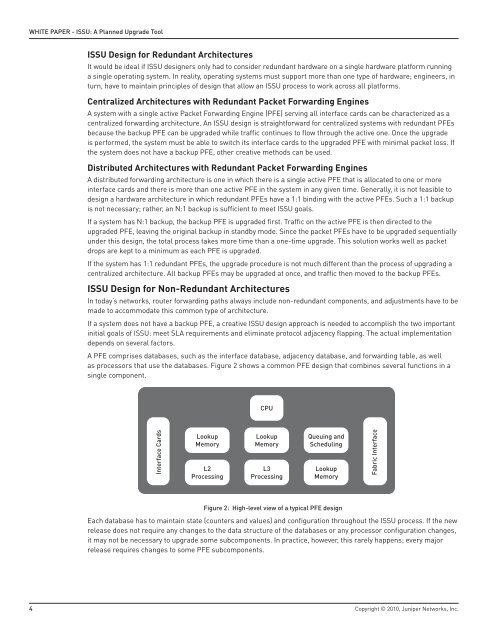ISSU: A Planned Upgrade Tool - Juniper Networks
ISSU: A Planned Upgrade Tool - Juniper Networks
ISSU: A Planned Upgrade Tool - Juniper Networks
Create successful ePaper yourself
Turn your PDF publications into a flip-book with our unique Google optimized e-Paper software.
WHITE PAPER - <strong>ISSU</strong>: A <strong>Planned</strong> <strong>Upgrade</strong> <strong>Tool</strong><br />
<strong>ISSU</strong> Design for Redundant Architectures<br />
It would be ideal if <strong>ISSU</strong> designers only had to consider redundant hardware on a single hardware platform running<br />
a single operating system. In reality, operating systems must support more than one type of hardware; engineers, in<br />
turn, have to maintain principles of design that allow an <strong>ISSU</strong> process to work across all platforms.<br />
Centralized Architectures with Redundant Packet Forwarding Engines<br />
A system with a single active Packet Forwarding Engine (PFE) serving all interface cards can be characterized as a<br />
centralized forwarding architecture. An <strong>ISSU</strong> design is straightforward for centralized systems with redundant PFEs<br />
because the backup PFE can be upgraded while traffic continues to flow through the active one. Once the upgrade<br />
is performed, the system must be able to switch its interface cards to the upgraded PFE with minimal packet loss. If<br />
the system does not have a backup PFE, other creative methods can be used.<br />
Distributed Architectures with Redundant Packet Forwarding Engines<br />
A distributed forwarding architecture is one in which there is a single active PFE that is allocated to one or more<br />
interface cards and there is more than one active PFE in the system in any given time. Generally, it is not feasible to<br />
design a hardware architecture in which redundant PFEs have a 1:1 binding with the active PFEs. Such a 1:1 backup<br />
is not necessary; rather, an N:1 backup is sufficient to meet <strong>ISSU</strong> goals.<br />
If a system has N:1 backup, the backup PFE is upgraded first. Traffic on the active PFE is then directed to the<br />
upgraded PFE, leaving the original backup in standby mode. Since the packet PFEs have to be upgraded sequentially<br />
under this design, the total process takes more time than a one-time upgrade. This solution works well as packet<br />
drops are kept to a minimum as each PFE is upgraded.<br />
If the system has 1:1 redundant PFEs, the upgrade procedure is not much different than the process of upgrading a<br />
centralized architecture. All backup PFEs may be upgraded at once, and traffic then moved to the backup PFEs.<br />
<strong>ISSU</strong> Design for Non-Redundant Architectures<br />
In today’s networks, router forwarding paths always include non-redundant components, and adjustments have to be<br />
made to accommodate this common type of architecture.<br />
If a system does not have a backup PFE, a creative <strong>ISSU</strong> design approach is needed to accomplish the two important<br />
initial goals of <strong>ISSU</strong>: meet SLA requirements and eliminate protocol adjacency flapping. The actual implementation<br />
depends on several factors.<br />
A PFE comprises databases, such as the interface database, adjacency database, and forwarding table, as well<br />
as processors that use the databases. Figure 2 shows a common PFE design that combines several functions in a<br />
single component.<br />
Interface Cards<br />
Lookup<br />
Memory<br />
L2<br />
Processing<br />
Figure 2: High-level view of a typical PFE design<br />
Each database has to maintain state (counters and values) and configuration throughout the <strong>ISSU</strong> process. If the new<br />
release does not require any changes to the data structure of the databases or any processor configuration changes,<br />
it may not be necessary to upgrade some subcomponents. In practice, however, this rarely happens; every major<br />
release requires changes to some PFE subcomponents.<br />
4 Copyright © 2010, <strong>Juniper</strong> <strong>Networks</strong>, Inc.<br />
CPU<br />
Lookup<br />
Memory<br />
L3<br />
Processing<br />
Queuing and<br />
Scheduling<br />
Lookup<br />
Memory<br />
Fabric Interface
















